Zip-line
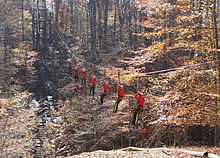
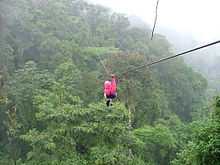
A zip-line (or zip line, zip wire, aerial runway, aerial ropeslide, death slide, flying fox, or foefie slide (in South Africa))[1][2][3][4] consists of a pulley suspended on a cable, usually made of stainless steel, mounted on an incline. It is designed to enable a user propelled by gravity to travel from the top to the bottom of the inclined cable by holding on to, or attaching to, the freely moving pulley. Zip-lines come in many forms, most often used as a means of entertainment. They may be short and low, intended for child's play and found on some playgrounds. Longer and higher rides are often used as a means of accessing remote areas, such as a rainforest canopy. Zip line tours are becoming popular vacation activities, found at outdoor adventure camps or upscale resorts, where they may be an element on a larger challenge or ropes course.[5] The jungles of Costa Rica, Florida, Puerto Vallarta,and Nicaragua are popular destinations for zip line enthusiasts.
History
The zip-wire has been used as a transportation method in some mountainous countries for many years.[6] In some remote areas in China, zip lines serve the purposes of bridges across rivers. Referred to as "an inclined strong",[7] one appears in The Invisible Man by H. G. Wells, published in 1897, as part of a Whit-Monday fair.
In 1739, Robert Cadman, a steeplejack and ropeslider, died when descending from Shrewsbury's St Mary’s Church when his rope snapped.[8]
Alberto Santos-Dumont used a direct ancestor of the zip-line in spring 1906 for a method of testing various characteristics of his 14bis pioneer era canard biplane, before it ever flew under its own power later that year.
In the Australian outback, zip-lines were occasionally used for delivering food, cigarettes or tools to people working on the other side of an obstacle such as a gully or river. Australian troops have used them to deliver food, mail and even ammunition to forward positions in several conflicts.
Flying fox
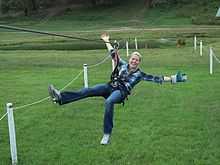
The term "flying fox" is most commonly used in reference to a small-scale zip line typically used as an item of children's play equipment, except in Australia and New Zealand where it also refers to professional forms of zip-line equipment.[9][10]
With the flying fox, the pulley(s), attached to the car, are fixed to the cable. The car itself can consist of anything from a simple hand grip, with the user hanging underneath, to a bucket for transporting small items, to a quite elaborate construction, perhaps including a seat or a safety strap. Children's versions are usually not set up with a steep incline, so the speeds are kept relatively low, negating the need for a means of stopping.
To be propelled by gravity, the cable needs to be on a fairly steep slope. Even then the car will generally not travel completely to the end (although this will depend on the load), and some means of safely stopping the car at the bottom end is sometimes needed. It can be returned by several means, either by simply pushing the car back to the top of the hill on foot (as is common in children's play equipment as they do not hang far from the ground) or a line leading from the car to the uphill end.
The flying fox is usually made with rope instead of steel cable to make it easier and cheaper to install, uninstall and transport.
Professional courses
Professional versions of a zip-line are most typically used as an outdoor adventure activity. In contrast to "flying foxes" professional courses are usually operated at higher speeds, covering much longer distances and sometimes at considerable heights. The users are physically attached to the cable by a harness that attaches to a removable trolley. A helmet is required on almost all courses of any size.
Cables can be very high, starting at a height of over 9 m (30 ft), and traveling well over 460 m (1,510 ft). All zip-line cables have some degree of sag. The proper tensioning of a cable is important and allows the ability to tune the ride of a zip line.
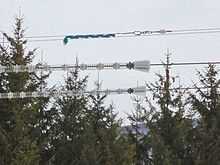
Users of zip-lines must have means of stopping themselves. Typical mechanisms include:[11]
- Friction created between the pulley against the cable
- Thick purpose-built leather gloves
- A mat or netting at the lower end of the incline
- A passive arrester system composed of springs, pulleys, counterweights, bungee cord, tire or other devices, which slows and then stops the trolley's motion
- A "capture block" which is a block on the cable that is tethered to a rope controlled by a staff who can manually apply friction on the rope to slow the user down
- Gravity stop, exploiting the sag in the cable. The belly of the cable is always lower than the termination point. The amount of uphill on a zip line controls the speed at which the user arrives at the termination point.
Also, a user can be stopped with a hand brake at the end of the zip line, such as at The Canyons Zip Line in Florida.
Zip lines are a common way to return participants to the ground at the end of a ropes adventure course.
With proper knowledge and training on the part of the operators and good maintenance, zip lines are safe and easy to use.
Records
The worlds biggest (length and height) zip line was built by action sports athlete Mike Wilson in January 2012. The zipline was permitted for 1 month by the FAA, and was 4,970 feet wide, and almost 2,500 feet high. This was also the first manmade terminal BASE jump in the United States.
According to Zip Line Rider the longest zip line (as of September 2013) was The Eye of the Jaguar at 2,130 m (6,990 ft), located 45 minutes north of Cusco, Peru in the Sacred Valley.[12]
Africa had for a long time the longest zip line at 2 km. The UNREAL Zip 2000 line doesn't use an end brake because riders return to the bottom of the loop to disembark.[13] It claims an average speed of 120 km/h and a top speed of 160 km/h.[14]
In 2012, ZipFlyer Nepal (HighGround Adventures) was reputed to be the world's steepest, tallest, and longest zip line. It had a total distance of 1.80 km (1.12 mi) end to end, a vertical drop of 610 m (2,000 ft), and 120 km/h (75 mph) top speed.[15][16]
In North America the ZipRider cable ride at Icy Strait Point, Alaska, was a massive installation with 6 side by side cables of about 1 mile each (1,624 m (5,328 ft)) with a 350 m (1,150 ft) vertical drop[17] claimed the longest run in 2013.
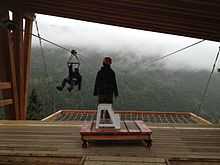
In July 2013 Canada's newest longest lines, SuperFly, opened at Whistler. There are 6 tandem lines with 2 of them 1.2 km and 1.3 km long.[18]
Zip World has opened a 1.80 km (1.12 mi) long zip line at Penrhyn Quarry, Bethesda, Wales, which is claimed to be the longest in Europe and reach speeds of 160 km/h (99 mph).[19]
Zip-line trolley
The zip-line trolley is the frame or assembly together with the pulley(s) also known as sheave(s) inside that run along the cable. (The term "trolley" is more often used when this assembly consists of more than a single pulley with simple hanger and bearing.) Often more than one pulley is used to spread the load over more than one spot on the cable, to reduce cable bending stresses that may lead to metal fatigue and cable breakage. This also reduces any tendency of a pulley to twist sideways and run off the cable, with disastrous results. In addition, the trolley is usually shaped with guards to hold the cable in the groove(s) of the pulley(s).
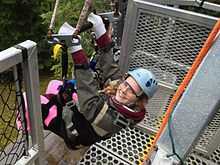
A pivoting link, such as a carabiner, is used to secure the load to the trolley so that the trolley does not have a tendency to rock and thus fall off the cable if the load should sway. Load carriers ranging from enclosed cabins to gondolas to harnesses are attached to the link. Occasionally the load carrier is just a handhold or handlebar, although there is the danger of the rider's losing his grip and falling. Such a simple carrier should be used only on zip lines that are near the ground or over water. The rider losing his grip due to the use of the simple carrier has led to ten deaths in two years alone (2010–2012).
Transportational
Yungas, Bolivia, features a system of zip lines used for transporting harvested crops.
See also
- Adventure park
- Boatswain's chair
- Breeches buoy
- Canopy tour
- Tyrolean traverse
- "I Should Have Never Gone Ziplining" (South Park episode)
References
- ↑ Who Really Benefits from Tourism, Publ. Equations, Karnataka, India, 2010. Working Papers Series. "Canopy Tourism", page 37
- ↑ Jacques Marais, Lisa De Speville, Adventure Racing, Publisher Human Kinetics, 2004, ISBN 0736059113, 9780736059114, 160 pages, page 156
- ↑ Also online at the publishers here
- ↑ http://www.collinsdictionary.com/dictionary/english/foefie-slide
- ↑ Thayer, Matthew (September–October 2008). "Don't Look Down!". Maui No Ka ‘Oi magazine (Maui, Hawaii). Retrieved 9 March 2011.
- ↑ "Aerial ropeways: automatic cargo transport for a bargain". LOW-TECH MAGAZINE, Doubts on progress and technology. Retrieved 2014-08-28.
- ↑ See the second paragraph here where the phrase is underlined.
- ↑ Plaque on Cadman's grave, St Mary's Church, Shrewsbury, UK
- ↑ "Zip Lines, Flying Fox in Australia". Ziplinerider.com. Retrieved 9 August 2012.
- ↑ "Zip Lines, Flying Fox in New Zealand". Ziplinerider.com. Retrieved 9 August 2012.
- ↑ Roper, Aaron. "Zip Line Braking Methods". ZipLineGear Knowledge Base. Retrieved 2 February 2015.
- ↑ "Longest Zip Lines". Ziplinerider.com. Retrieved 2013-09-29.
- ↑ "UNREAL Zip 2000". Retrieved 17 Sep 2013.
- ↑ "The Sun City Zip 2 000 slide is the longest in the world – South African Tourism". Southafrica.net. Retrieved 2013-09-29.
- ↑ "HGnepal Website". Retrieved 4 July 2012.
- ↑ ""Longest Zip Lines" at ziplinerider.com". Retrieved 17 Apr 2012.
- ↑ "Zipline Videos". Retrieved 4 August 2013.
- ↑ Banks, Feet (2013-08-19). "Whistler Insider Blog | Whistler Ziplines Part 1 : Superfly Ziplines". Whistler.com. Retrieved 2013-09-29.
- ↑ "100mph zip line opens at Penrhyn Quarry, Bethesda". 21 March 2013. Retrieved 27 March 2013.
External links
| Wikimedia Commons has media related to Zip lines. |
| Wikivoyage has a travel guide for Ziplining. |
| Look up flying fox in Wiktionary, the free dictionary. |
- Canopying at DMOZ
- "Smugglers busted over zip wire border racket". Reuters. 29 May 2008. Retrieved 28 February 2013.
- Outdoor Philadelphia, Zip Line. Philly.com. 24 July 2008. Retrieved 28 February 2013.
- "Zip-line industry has another side to it". Vancouver Sun. 13 May 2008. Retrieved 28 February 2013.
- "‘Polarizing' zipline plan aired in Chase". The Kamloops Daily News (British Columbia, Canada). 22 February 2011. Retrieved 28 February 2013.
| ||||||||||||||||||||||||||||||||||||||||||||||||||